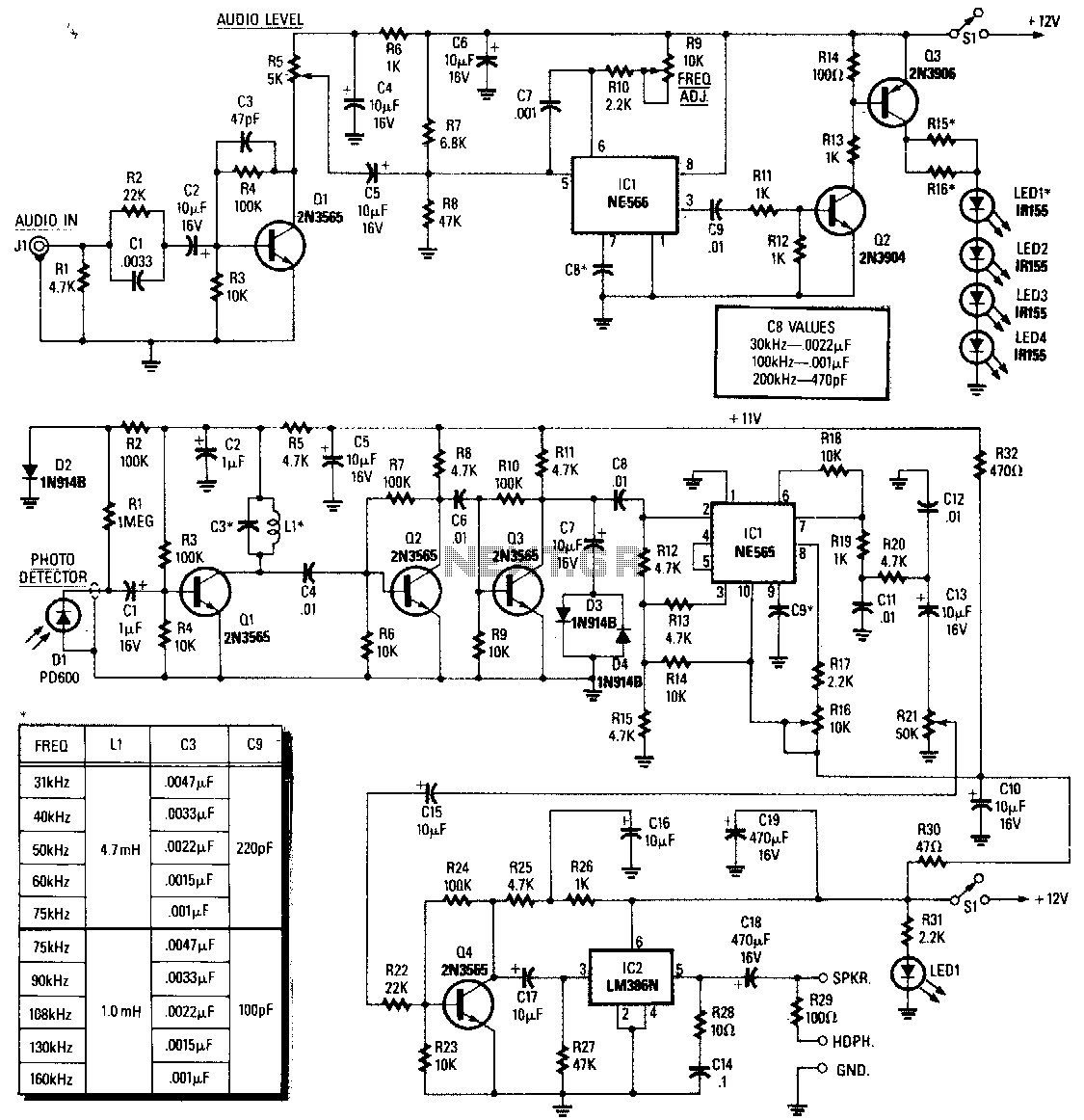
Infrared-wireless-speaker-system

The infrared (IR) region is free from radio interference but can experience disruptions from incandescent lamps, fluorescent lamps, stray reflections, and other sources. A straightforward solution to this issue is to generate a carrier by modulating the IR radiation at a frequency of 100 kHz. The audio signal then modulates this carrier by varying the chopping rate. A receiver subsequently detects the IR beam as a 100-kHz frequency-modulated (FM) signal. The primary drawback is that a high-gain FM receiver is required instead of a simple audio amplifier. However, with the integrated circuits (ICs) currently available, constructing an FM receiver is relatively easy and requires minimal additional circuitry compared to a high-gain audio amplifier. Kits for this purpose can be obtained from North Country Radio, P.O. Box 53, Wykagyl Station, NY 10804.
The described circuit utilizes infrared (IR) modulation techniques to transmit audio signals effectively while minimizing interference from various light sources. The core of the system involves a transmitter that generates a 100 kHz carrier signal by modulating the IR light source. This modulation is accomplished through a chopping mechanism that turns the IR light on and off at the specified frequency.
The audio signal, which contains the information to be transmitted, modulates the carrier frequency. This modulation can be achieved using a voltage-controlled oscillator (VCO) or a similar device that can vary the frequency of the carrier signal based on the amplitude of the incoming audio signal. The result is an FM signal that carries the audio information over the IR beam.
On the receiving end, the IR detector, typically a photodiode or phototransistor, is configured to sense the modulated IR light. The output from the detector is then fed into a high-gain FM receiver circuit. The receiver demodulates the FM signal, extracting the original audio information for amplification and playback through speakers or other audio output devices.
The requirement for a high-gain FM receiver is a notable aspect of this design, as it ensures that the modulated signal can be effectively processed even in the presence of potential interference. Modern ICs simplify the construction of such FM receivers, allowing for compact designs that integrate necessary functionalities without extensive additional circuitry.
The availability of kits from suppliers such as North Country Radio facilitates the implementation of this system for hobbyists and engineers alike, providing essential components and guidance for building a reliable IR audio transmission system.Although theIR region is free from radio interference, it is subject to interference from incandescent lamps, fluorescent lamps, stray reflections, and other sources. A simple way to overcome that problem is to create a carrier by chopping the IR radiation at a rate of 100 kHz.
The audio then modulates the carrier by modulating the chopping rate. A receiver then detects the IR beam as a 100-kHz FM signal. The only disadvantage is that instead of a simple audio amplifier, a high-gain FM receiver is necessary. However, with the !Cs that are now available, an FM receiver is easy to build, and contains little more circuitry than a high-gain audio amplifier.
The kit is available from North Country Radio, P.O. Box 53, Wykagyl Station, NY 10804.
The described circuit utilizes infrared (IR) modulation techniques to transmit audio signals effectively while minimizing interference from various light sources. The core of the system involves a transmitter that generates a 100 kHz carrier signal by modulating the IR light source. This modulation is accomplished through a chopping mechanism that turns the IR light on and off at the specified frequency.
The audio signal, which contains the information to be transmitted, modulates the carrier frequency. This modulation can be achieved using a voltage-controlled oscillator (VCO) or a similar device that can vary the frequency of the carrier signal based on the amplitude of the incoming audio signal. The result is an FM signal that carries the audio information over the IR beam.
On the receiving end, the IR detector, typically a photodiode or phototransistor, is configured to sense the modulated IR light. The output from the detector is then fed into a high-gain FM receiver circuit. The receiver demodulates the FM signal, extracting the original audio information for amplification and playback through speakers or other audio output devices.
The requirement for a high-gain FM receiver is a notable aspect of this design, as it ensures that the modulated signal can be effectively processed even in the presence of potential interference. Modern ICs simplify the construction of such FM receivers, allowing for compact designs that integrate necessary functionalities without extensive additional circuitry.
The availability of kits from suppliers such as North Country Radio facilitates the implementation of this system for hobbyists and engineers alike, providing essential components and guidance for building a reliable IR audio transmission system.Although theIR region is free from radio interference, it is subject to interference from incandescent lamps, fluorescent lamps, stray reflections, and other sources. A simple way to overcome that problem is to create a carrier by chopping the IR radiation at a rate of 100 kHz.
The audio then modulates the carrier by modulating the chopping rate. A receiver then detects the IR beam as a 100-kHz FM signal. The only disadvantage is that instead of a simple audio amplifier, a high-gain FM receiver is necessary. However, with the !Cs that are now available, an FM receiver is easy to build, and contains little more circuitry than a high-gain audio amplifier.
The kit is available from North Country Radio, P.O. Box 53, Wykagyl Station, NY 10804.